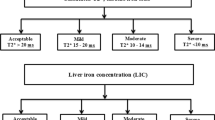Abstract
Background
Thalassemia major is one of the most common hereditary disorders, and it causes ineffective hematopoiesis in the body through disarrangement of the hemoglobin synthesis balance. Regular blood transfusions cause complications of iron overload in the body in these patients. Tissue iron status can be determined by measuring serum and liver biopsy ferritin levels and by T2* MRI. This study assessed the relationship between serum ferritin and hemoglobin by T2* MRI of the heart and liver.
Method
This cross-sectional descriptive study was carried out on patients with beta-thalassemia intermedia and major who visited the Center for Thalassemia and Hemoglobinopathies at Shafa Hospital, Ahwaz, between 2014 and 2015. All patients were receiving regular blood transfusions every 2‒4 weeks. Pearson’s correlation test was used to assess serum ferritin and T2* values from heart and liver MRI.
Results
A total of 260 patients (mean age is 23-year-old) were enrolled in the study. The incidence of iron overload in the liver and heart was 83% and 39%, respectively. Serum ferritin levels showed a very strong inverse correlation with T2* values on heart (r = -3.54, p<0.0001) and liver (r = -3.03, p<0.0001) MRI. Additionally, a meaningful interaction was observed between the T2* values from liver and heart MRI (r = 0.29, p<0.0001).
Conclusion
Serum ferritin is strongly and inversely correlated with T2* values of MRI of the liver and heart in patients with thalassemia. Therefore, T2* MRI can be used to assess tissue iron levels with very high accuracy.
Similar content being viewed by others
References
Anderson L J, Holden S, Davis B, Prescott E, Charrier C C, Bunce N H, Firmin D N, Wonke B, Porter J, Walker J M, Pennell D J (2001). Cardiovascular T2-star (T2*) magnetic resonance for the early diagnosis of myocardial iron overload. Eur Heart J, 22(23): 2171–2179
Azarkeivan A, Hashemieh M, Shirkavand A, Sheibani K (2016). Correlation between Heart, Liver and Pancreas Hemosiderosis Measured by MRI T2* among Thalassemia Major Patients from Iran. Arch Iran Med, 19(2): 96–100
Borgna-Pignatti C, Rugolotto S, De Stefano P, Zhao H, Cappellini M D, Del Vecchio G C, Romeo M A, Forni G L, Gamberini M R, Ghilardi R, Piga A, Cnaan A (2004). Survival and complications in patients with thalassemia major treated with transfusion and deferoxamine Haematologica, 89(10): 1187–1193
Cao A, Galanello R (2010). Beta-thalassemia. Genet Med, 12(2): 61–76
Chen X, Zhang Z, Zhong J, Yang Q, Yu T, Cheng Z, Chan Q, Guo H, Liang B (2015). MRI assessment of excess cardiac iron in thalassemia major: When to initiate? J MagnReson Imaging, 42(3): 737–745
Cunningham M J, Macklin E A, Neufeld E J, Cohen A R, and the Thalassemia Clinical Research Network (2004). Complications of beta-thalassemia major in North America. Blood, 104(1): 34–39
Eghbali A, Taherahmadi H, Shahbazi M, Bagheri B, Ebrahimi L (2014). Association between serum ferritin level, cardiac and hepatic T2-star MRI in patients with major β-thalassemia. Iran J Ped Hematol Oncol, 4(1): 17–21
Galanello R, Origa R (2010). Beta-thalassemia. Orphanet J Rare Dis, 5 (1): 11
Khosravi A, Jalali-Far M, Saki N, Hosseini H, Galehdari H, Kiani-Ghalesardi O, Paridar M, Azarkeivan A, Magaji-Hamid K (2016). Evaluation of α-Globin Gene Mutations Among Different Ethnic Groups in Khuzestan Province, Southwest Iran. Hemoglobin, 40(2): 113–117
Majd Z, Haghpanah S, Ajami G H, Matin S, Namazi H, Bardestani M, Karimi M (2015). Serum Ferritin Levels Correlation With Heart and Liver MRI and LIC in Patients With Transfusion-Dependent Thalassemia. Iran Red Crescent Med J, 17(4): e24959
Mazza P, Giua R, De Marco S, Bonetti M G, Amurri B, Masi C, Lazzari G, Rizzo C, Cervellera M, Peluso A, et al (1995). Iron overload in thalassemia: comparative analysis of magnetic resonance imaging, serum ferritin and iron content of the liver. Haematologica, 80(5): 398–404
Merchant R, Joshi A, Ahmed J, Krishnan P, Jankharia B (2011). Evaluation of cardiac iron load by cardiac magnetic resonance in thalassemia. Indian Pediatr, 48(9): 697–701
Ooi G C, Khong P L, Chan G C, Chan K N, Chan K L, Lam W, Ng I, Ha S Y (2004). Magnetic resonance screening of iron status in transfusion-dependent β-thalassaemia patients. Br J Haematol, 124(3): 385–390
Rachmilewitz E A, Giardina P J (2011). How I treat thalassemia. Blood, 118(13): 3479–3488
Shabanian R, Heidari-Bateni G, Kocharian A, Mashayekhi M, Hosseinzadeh S, Kiani A, Izadyar M, Koochakzadeh L (2010). Augmentation of left atrial contractile function: a herald of iron overload in patients with beta thalassemia major. Pediatr Cardiol, 31(5): 680–688
Wood J C, Fassler J D, Meade T (2004). Mimicking liver iron overload using liposomal ferritin preparations. Magn Reson Med, 51(3): 607–611
Alústiza J M, Emparanza J I, Castiella A, Casado A, Garrido A, Aldazábal P, San Vicente M, Garcia N, Asensio A B, Banales J, Salvador E (2015). Measurement of liver iron concentration by MRI is reproducible. Biomed Res Int, 2015:294024
Acknowledgments
This study was performed in Ahwaz Ahafa Hospital, Ahvaz, Iran; we are grateful to its personnel. We also appreciate Dr.Pedram’s revision of the manuscript.
Author information
Authors and Affiliations
Corresponding author
Rights and permissions
About this article
Cite this article
Keikhaei, B., Slehi-fard, P., Nojoumi, SA. et al. Relationship between serum ferritin and hemoglobin levels determined by cardiac and hepatic T2 MRI in beta-thalassemia intermedia and major patients. Front. Biol. 12, 311–315 (2017). https://doi.org/10.1007/s11515-017-1431-9
Received:
Accepted:
Published:
Issue Date:
DOI: https://doi.org/10.1007/s11515-017-1431-9



